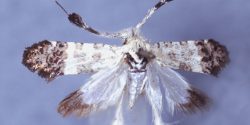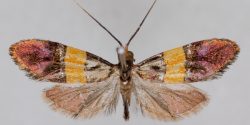Past research
During the 1980s and 1990s, I intensively studied the thoracal morphology of moths and butterflies in connection with insect flight. I described over 100 taxa of fossil and recent insects (primarily moths), ranging from sub-species to sub-orders. My taxonomic research focussed on archaic moths of the families Micropterigidae, Eriocraniidae, Opostegidae, Tisheriidae, Prodoxidae, Incurvariidae and Adelidae.
Ongoing research
I am preparing for publication descriptions of over 100 new species of the genus Nemophora (Lepidoptera: Adelidae) and am analysing the phylogeny of the family Adelidae based on morphological and DNA data.
Featured publications
Lassance, J. M., Svensson, G. P., Kozlov, M. V., Francke, W. & Löfstedt, C. (2019) Pheromones and barcoding delimit boundaries between cryptic species in the primitive moth genus Eriocrania (Lepidoptera: Eriocraniidae). Journal of Chemical Ecology, 45, 429‒439 (doi: 10.1007/s10886-019-01076-2).
We combined pheromone trapping and genetic analysis to elucidate the evolutionary relationships within a complex of primitive moth species (Lepidoptera: Eriocraniidae). Mitochondrial and nuclear DNA markers provided evidence that Eriocrania semipurpurella, as currently defined by morphological characters, includes three cryptic species in Northern and Western Europe. Male moths of these cryptic species are attracted to different ratios of two major pheromone components, (2S,6Z)-nonen-2-ol and (2R,6Z)-nonen-2-ol. Our data suggest strong assortative mating in these species in the absence of apparent niche separation, indicating that Eriocrania moths may represent an example of non-ecological speciation.
Kozlov, M. V., Mutanen, M., Lee, K. M. & Huemer, P. (2017) Cryptic diversity in the long-horn moth Nemophora degeerella (Lepidoptera: Adelidae) revealed by morphology, DNA barcodes and genome-wide ddRAD-seq data. Systematic Entomology, 42, 329‒346 (doi: 10.1111/syen.12216).
We found that Nemophora degeerella (L.), as currently defined by morphological characters, consists of three taxa: N. degeerella, which is widely distributed across temperate Europe north of the Alps, from Portugal to Finland, Central Russia and Ukraine; N. scopolii sp.n., which inhabits central and southern Europe (Slovakia, southern Germany, Austria, Slovenia and Italy); and N. deceptoriella sp.n. from the Caucasus (Russia and Georgia). These species are separated by subtle but stable external morphological characters and divergent cytochrome c oxidase subunit I (COI) lineages, with at least one geographical region (Austria to southern Germany and Slovakia) where two of these species (N. degeerella and N. scopolii) co‐occur.
Kozlov, M. V. (2016) Taxonomic revision of Australian long-horn moths of the genus Nemophora (Lepidoptera: Adelidae). Zootaxa, 4097, 84–100 (doi: 10.11646/zootaxa.4097.1.4)
The fauna of Australia currently includes seven valid species of Nemophora, which form a monophyletic laurella species-group. Keys to species based on external characters and on male genitalia are provided; adults and male genitalia are described and illustrated.
Kozlov, M. V. (2013) A new species of the genus Adela (Lepidoptera: Adelidae) from South America. Neotropical Entomology, 42, 505-507 (doi: 10.1007/s13744-013-0150-4).
Adela boliviella n. sp., described from central Bolivia, is the first representative of the subfamily Adelinae found in South America.
Kozlov M. V. (2011) Ground plan and evolution of pterothoracic musculature of moths and butterflies (Lepidoptera). Entomological Review, 90, 833-853 (doi: 10.1134/S0013873812020054)
Investigation of the meso- and metathoracic musculature in 62 species of Lepidoptera revealed 40 topographically different muscles, 37 of which presumably belong to the ground plan. The thoracic anatomy of Lepidoptera is strongly linked with biomechanics of flight and therefore has a relatively low value for phylogenetic analysis.
Kozlov, M. V. (2004) Annotated checklist of the European species of Nemophora (Adelidae). Nota Lepidopterologica, 26, 115-126. (PDF)
The checklist includes 20 species so far reported from Europe, along with most important synonymy and comments about the characters useful for identification of the problematic species.
Co-authors
D. Agassiz
G. Esartia
D. Grodnitsky
T. Hirovatari
P. Huemer
V. Ivanov
L. Kaila
O. Karsholt
†N. P. Kristensen
†V. I. Kuznetzov
M. Motorkin
M. Mutanen
M. Nesina
E. J. van Nieukerken
R. Pupljasis
A. P. Rasnitsyn
†G. S. Robinson
S. Seksyaeva
S. Sinev
A. A. Stekolnikov
N. Wahlberg
Co-operating scientists
D. Davis
W. Mey
L. Przybylowicz
K. Tuck
S.-H. Yen
and over 50 other taxonomists from around the world
Funding
EC through SYS Resource and SYNTHESYS programmes
Academy of Finland
Finnish Cultural Foudation
Oskar Öflunds Stiftelse

